Behind the photos: Venoms and Toxins 2022 Snakebite photo competition
Gnaneswar Chandrasekharun (First place)
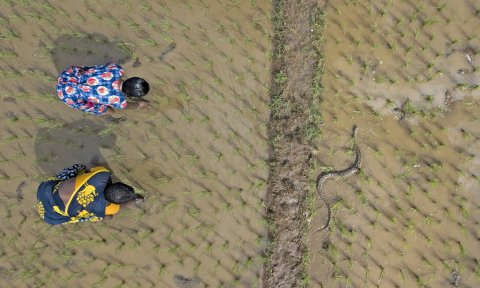
Photo title: Shared landscapes
Photo credit: Gnaneswar Ch
Photo caption: Snakes are an important part of agrarian landscapes, as rodent controllers. Being an epicenter for snakebite, at least 58,000 people die in India annually. Russell's vipers are considered to contribute to most of these deaths but if they aren't provoked they cause no harm and can coexist peacefully as seen in the picture. The complexities in treatment, venom variation, and poor policies make it a nightmare for the victims. Preventive education plays a massive role in avoiding snakebites since most snakebites are accidents. Sensitizing communities with simple prevention measures and knowledge of snakebite contributes significantly towards mitigation.
How did the photo come about?
On a snake walk with Irulas, an endemic tribe that’s known for catching snakes, I happen to notice a snake crawling in the rice fields. I have noticed that it was not very far from few women who were working in the field. The Russell’s viper gently went past women without feeling threatened or noticed. I was often told that snakes do not bite unless provoked and this incident made me believe fully in it. I wanted to recreate this incidence to prove that people and snakes can coexist. This particular image was clicked on a later day when we released rescued vipers in the farmlands. Upon releasing, we cautioned the two women about the snake’s presence and they were carefully keeping an eye on the snake. The viper however, without hesitation, crawled parallel to these women without feeling threatened. The picture was taken using a drone and under an expert’s supervison.
Hiral Naik (Highly Commended)
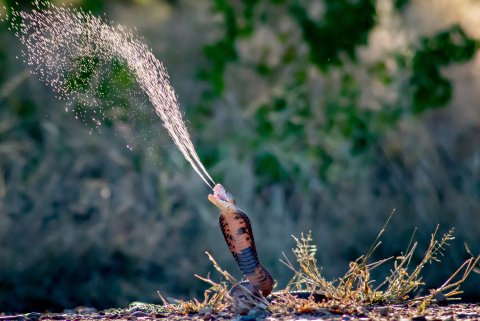
Photo title: A Mozambique spitting cobra defending itself by spitting venom
Photo credit: Hiral Naik
Photo caption: A Mozambique spitting cobra is spitting its venom as a defense mechanism towards any threat it experiences. The snake's instinct is to spit to defend itself.
How did the photo come about?
Mozambique spitting cobra are common snakes in the Hoedspruit area of South Africa, where I am based. They are medically important venomous snakes that spit their venom to defend themself against any perceived threat. This snake was rescued from a house where people felt threatened by it. To collect important information and metrics on the snake for research purposes, the snake was captured and brought back to the Hoedspruit Reptile Centre.
When the snake was ready to be released, it was a good opportunity to take a photo, particularly to capture its behaviour. When released, the snake spat as a defence mechanism and the spitting distance of this snakes came as quite a surprise. However, it made for a lovely photograph. The snake then moved off into the bush to safety. As human-snake conflict is a common occurrence, it is important to learn about the interactions between humans and snakes.
Oliver G. Becker (Highly Commended)

Photo title: Kraits at Night
Photo credit: Oliver G. Becker / Occasione Documentaries
Photo caption: Bites by kraits are a leading cause of snakebite mortality in Southeast Asia. They typically occur at night, on sleeping people and cause neuromuscular paralysis. Kraits produce very small amounts of venom and have only short fangs to inject it. Thus, conventional ways of venom extraction are ineffective. In this photo, Prof. Md. Farid Ahsan (University of Chittagong) and Dr. Ulrich Kuch (Goethe University Frankfurt) collect venom from a common krait using a microcapillary tube. Part of a larger team led by Prof. Aniruddha Ghose, the scientists from Bangladesh and Germany collaborate in the Venom Research Centre (VRC) of Bangladesh.
How did the photo come about?
Bites by kraits (genus Bungarus) are a leading cause of snakebite mortality in South and Southeast Asia. They typically occur at night, on sleeping people, and mainly cause neuromuscular paralysis that is difficult to treat. In the past, a single species (the common krait, Bungarus caeruleus) had been thought to cause almost all krait bites in South Asia. As a result, up to this day this species is the only krait in South Asia that is used in antivenom production. However, research carried out in the last 20 years has shown that the diversity of krait species and their toxins is much greater than previously believed, that several krait species are medically important in South Asia, and that their venoms are only poorly neutralized by the existing antivenoms. Collectively, these findings from interdisciplinary, collaborative field, clinical, and laboratory studies have highlighted the importance of research on these nocturnal snakes, the variability of their venoms between and within species, and the development of improved and regionally appropriate diagnostic and therapeutic tools. Kraits produce very small amounts of venom and have only short fangs to inject it. Thus, conventional ways of venom extraction are ineffective and stressful for these snakes.
In this photo, Prof. Md. Farid Ahsan (University of Chittagong) and Dr. Ulrich Kuch (Goethe University Frankfurt) collect venom from a common krait (from Rangpur, northwestern Bangladesh) using a microcapillary tube that is gently put on the snake's fang. As the snake releases venom into the tube, the rest of its mouth is completely unaffected by the procedure. Improvements of animal keeping and handling, such as this, play an important role in making snake antivenom production more effective and affordable. Part of a larger team led by Prof. Aniruddha Ghose (Chittagong Medical College), the scientists from Bangladesh and Germany collaborate in the Venom Research Centre (VRC) of Bangladesh which is funded by the Non-Communicable Disease Control Programme of the Directorate General of Health Services, Ministry of Health and Family Welfare of the Government of Bangladesh.
Benjamin Jelle Visser (Top 10)
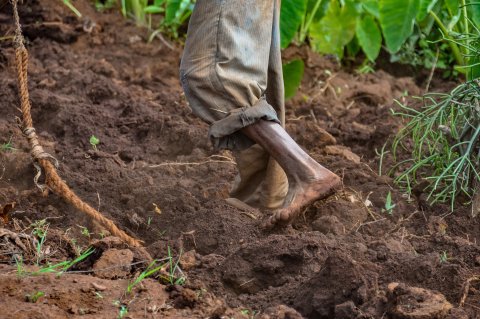
Photo title: The second before the snakebite
Photo credit: Dr. B.J. Visser
Photo caption: Can you discover the snake who is going to bite this farmer in his foot? This farmer, in the Ethiopian highlands, is working in wet, red volcanic red clay soils barefoot. This photo captures the moment just before the potential fatal snakebite. Snakebites are one of the main work-related health risk for farmers. It can be very challenging, even for experienced farmers, to recognize snakes in the field. Wearing shoes can prevent not only potential deadly snakebites, but also other barefoot-associated diseases such as soil-transmitted helminths, podoconiosis, bacterial infections (e.g. leptospirosis).
Prevent snakebites, wear shoes!
How did the photo come about?
This Ethiopian farmer is working on the land of his family and forefathers. Being a farmer in the highlands of Ethiopia is both a tough as well as a dangerous job. It earns just enough for living, but it is not enough to save money or pay the school fees for his 4 children aged 2, 4, 6 and 10 years old.
In the left lower corner of the picture, behind some old textile, an Ethiopian mountain adder (Bitis parviocula) is hiding. For the untrained eye it is very difficult to distinguish it from its surroundings. When the farmers unknowingly passes the snake on a close distance, it hissed, which alarms the farmer promptly. Just before the bit, the farmer manages to escape. Not much is known about the toxicity of the bit of the Ethiopian mountain adder, however, locals consider it very dangerous.
The picture was made during a project on podoconiosis, a geochemical form of elepthantiasis, caused by prolonged exposure to irritant clay soils. Wearing shoes could not only reduce the change of a toxic snakebite, but also decrease the risk on podoconiosis, and other neglected tropical diseases such as soil-transmited helminths. However, during the raining seasons, the red clay soil can become very sticky, making it difficult to work on the land with shoes, as they the soles of the shoes can be sucked and stick to the soil; a reason why farmers often do not use shoes. Moreover; most farmers do own (if they own at all) only one pair of shoes; they prefer to keep them clean for weddings or other official festivities. The lack of shoes increases the disease-poverty-disease cycle; owning a good pair of shoes should be a basic right just as access to clean water.
The photo was made during a research project on podoconiosis in the South of Ethiopia, in the mountains surrounding Sodo, Wolaita Region, Ethiopia.
Daniel Jestrzemsk (Top 10)

Photo title: Invisible striker
Photo credit: Daniel Jestrzemski
Photo caption: The terciopelo or fer-de-lance (Bothrops asper) is one of Latin America's most medically important snake species, being responsible for the majority of severe human envenomings within its distribution range, and also affecting livestock. As a nocturnal ambush predator and important natural control of rodent populations, this highly venomous pitviper has an X-shaped dorsal coloration pattern which perfectly blends with the leaf litter of its forest habitats, making it almost invisible. The photo shows a nearly 120 cm-long male, found at night on a Finca in the Ecuadorian Chocó, a rainforest ecoregion threatened by illegal logging and oil palm plantations.
How did the photo come about?
In early March 2020, I travelled from Germany to Ecuador as part of a joint herpetological research project between Goethe University Frankfurt (Frankfurt am Main, Germany) and Universidad Tecnológica Indoamericana (UTI, Quito, Ecuador). In Ecuador, I stayed mostly in the northwestern provinces of Pichincha and Esmeraldas, where pockets of remaining Pacific lowland rainforests form a part of the highly threatened Chocó–Darién ecoregion.
After sunset, I regularly went out for jungle hikes in Itapoa rainforest reserve, a small protected area established by conservationist Raul Nieto, who is working to preserve the Ecuadorian Chocó rainforests since 1990. On the night of Friday the 13th to Saturday, while hiking along a jungle trail in Itapoa, the body of a medium-sized, slender snake slithered out of the underwood in front of my feet. I was very excited to realize that it was a Terciopelo pitviper (Bothrops asper), the region's most feared snake species. After catching the pitviper with snakebite-proof gloves (Hexarmor), I transfered it into a linen bag, and later measured and released it in the open area for a brief nocturnal photo session in the soft rain. It was amazing to see how perfectly this highly dangerous pitviper blended into the leaf-littered ground at the rainforest edge. Two days after capture, I released the 117 cm-long adult male back into the wild and prepared to leave Ecuador, as the national lockdown due to COVID-19 began.
Edgar Neri (Top 10)

Photo title: Textures in vipers
Photo credit: Edgar Neri-Castro
Photo caption: Close-up of a Atheris squamigera, a species of the genus Atheris. Species of this genus have a very showy strongly keeled scale pattern.
How did the photo come about?
I work at the Institute of Biotechnology of the UNAM, Mexico studying the venom of snakes. In our laboratory we have a Herpetarium called "Cantil" in which we perform venom extractions. We have collaborations with different scientific collections that allow us to extract venom from their specimens, in this occasion DEVAL ANIMAL allowed us to extract venom from Atheris sp., prior to the venom extraction I took the time to take pictures that I normally use to divulge (disseminate) science. The photographs help us show to the general public the beauty and biological importance of these specimens.
Hamza Alghamdi (Top 10)
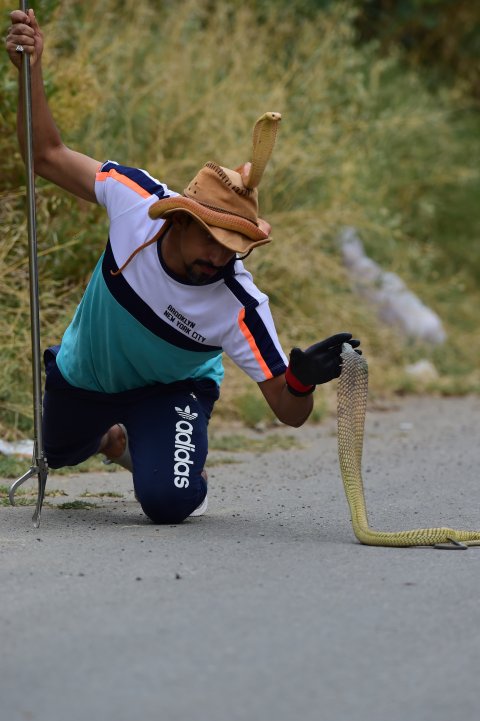
Photo title: Enemy friends
Photo credit: Saad Alghamdi
Photo caption: Baljurashi Governorate in the Al-Baha region in the south of the Kingdom of Saudi Arabia, above the Sarawat Mountains. A poisonous and strange Arab cobra appears in front of the hunter and above his head is his girlfriend, the Arab cobra, as she watches the hunter's dealings with the new cobra as he tries to deal with it gently and save it with love without using the iron stick so as not to harm it. (Translated from Arabic)
How did the photo come about?
I am the official spokesman for the Rahma Society for Animal Welfare in the Kingdom of Saudi Arabia. I hunt snakes in my area that the residents report to me, and I release them in nature later.
Suyog Khochare (Top 10)
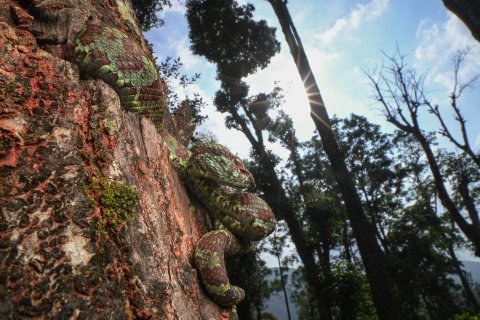
Photo title: Spooky surprise
Photo credit: Girish Vilas Choure
Photo caption: Coffee plantations of India are not only known for their rich quality coffee beans but also for these spectacularly camouflaged Craspedocephalus malabaricus or Malabar pit vipers. This snake species is highly venomous and their bites are clinically significant. Human beings economically dependent on coffee plantations for their livelihoods often suffer snake bites from Malabar pit vipers. While we might call this an attack, from the snake’s perspective it is defense – a never ending argument! In the picture is a wellcamouflaged C. malabaricus from the coffee plantations of Karnataka, India.
How did the photo come about?
The photo entitled ‘spooky surprise’, captures Malabar pit viper Craspedocephalus malabaricus which is endemic to the Western Ghats of India. The specimen was captured in the coffee plantations at Coorg which is not only renowned for unique coffee beans, but also houses stupendous biodiversity. Outdoor workers dependent on these coffee estates, trying to make their living have been closely working around and encountering these venomous species regularly. Interestingly, spotting a spectacularly camouflaged C. malabaricus snake in a coffee plantation has always been a challenging task often leading to several notorious bite incidents.
The unique herpetofauna of Western Ghats has always fascinated passionate naturalists. Incidentally, one such morning after endless showers, we stumbled upon one such specimen basking on a tree log blanketed with algal growth. Distinguishing and capturing this magnificent snake in a stationary position on a tree bark at just the right moment is an arduous job. Shout out to Girish Choure, a friend of mine and a passionate photography enthusiast who managed to spot this beautiful venomous reptile in the wild.
Valentine Musabyimana (Top 10)
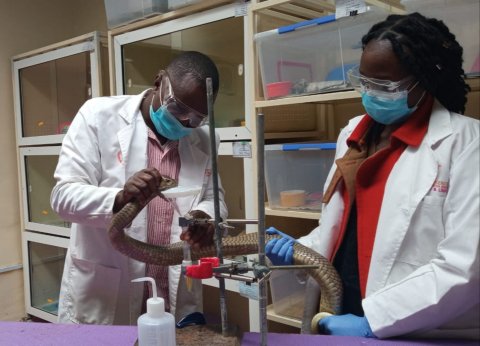
Photo title: Large brown spitting cobra venom extraction
Photo credit: Dr. Henry Emonje
Photo caption: Pictured here is myself, an assistant research scientist and the senior herpetologist Mr. Geoffrey Maranga of the Kenya Snakebite Research and Intervention Centre (KSRIC). The photo was taken at the KSRIC herpetarium, Institute of Primate Research Nairobi - Kenya.
In the photo, we are carrying out venom extraction from Naja ashei (the large brown spitting cobra) for purposes of snake venom characterization (toxicity determination and protein profiling) and antivenom efficacy testing.
How did this photo come about?
This photo was taken during routine snake venom extraction at the Kenya Snakebite Research and Intervention Centre (K-SRIC), Institute of Primate Research (IPR). In the photo, myself and our senior herpetologist Mr. Geoffrey Maranga were carrying out venom extraction from Naja ashei (the large brown spitting cobra) for purposes of snake venom characterization (toxicity determination and protein profiling) and antivenom efficacy testing. When we noticed the high yield of venom (8ml) from this snake, our assistant quickly took a picture of the process.
Yoshihiro Aoki (Top 10)
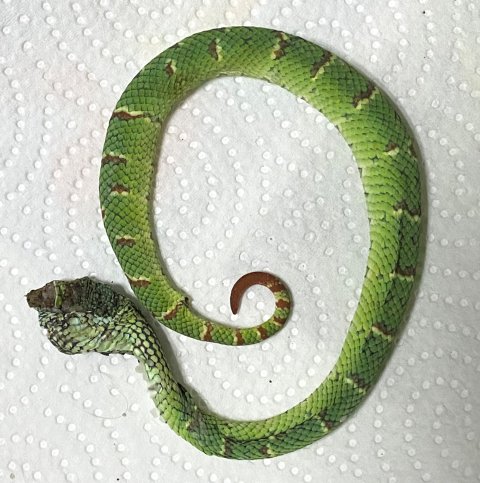
Photo title: Human-Snake Conflict: Philippine temple pit viper with its head crushed by the victim
Photo credit: Yoshihiro Aoki
Photo caption: A 40-year-old male farmer brought the snake after being bitten by juvenile Tropidolaemus sabammulatus under a coconut tree in Leyte, the Philippines. Two fang marks were seen on the lateral side of his right ankle, but the patient did not develop any symptoms and signs of envenomation: a dry bite was suspected. Sadly, the beautiful green snake was killed and brought voluntarily. In order to mitigate human-snake conflict, countermeasures for snake ecology conservation with community education are urgently needed in addition to reducing human snakebite mortality and morbidity.
How did the photo come about?
A 40-year-old male farmer brought the snake after being bitten by juvenile Tropidolaemus subannulatus under a coconut tree in Leyte, the Philippines. Two fang marks were seen on the lateral side of his right ankle, but the patient did not develop any symptoms and signs of envenomation: a dry bite was suspected. Sadly, the beautiful green snake was killed and brought voluntarily. The head of the snake was crushed by the victim.
The capturing and killing of wild snakes is generally not recommended to avoid secondary snakebite incidents and snake ecology destruction. However, fear and incorrect knowledge tend to make people act in an undesirable manner. In order to mitigate human-snake conflict, countermeasures for snake ecology conservation supported by community engagement are urgently needed, in addition to reducing human snakebite mortality and morbidity.
A hospital-based prospective observational study of snakebite envenomation is ongoing in the tertiary hospital in Leyte. Socio-demographic and pre-hospital management information collected in this study will be helpful to understand challenges and barriers, and develop community-based interventions.